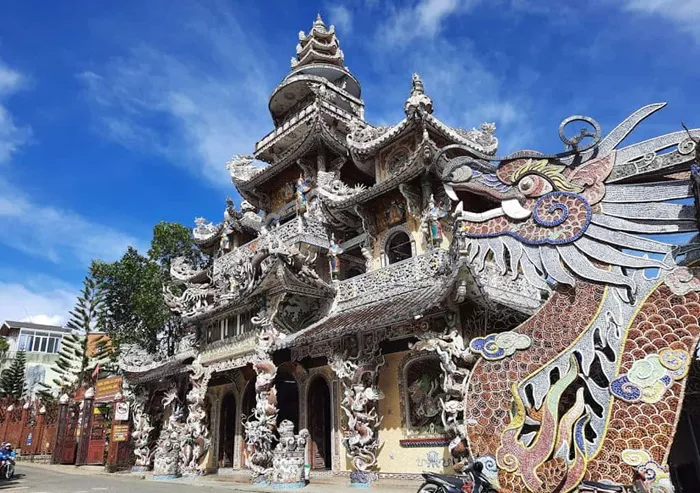Linh Phuoc Pagoda is one of the most famous Buddhist temples in Vietnam. Located in Da Lat city, Lam Dong province, this pagoda attracts many visitors for its unique beauty and deep spiritual meaning. It is well-known for its special landscapes, lively religious activities, and its careful conservation efforts.
Special Landscapes of Linh Phuoc Pagoda
Unique Temple Architecture
The architecture of Linh Phuoc Pagoda is very special. It combines traditional Buddhist architecture with creative use of materials. The entire pagoda is decorated with thousands of colorful glass shards, broken pottery, and porcelain. This mosaic style gives the pagoda a bright and shining look.
The main hall is large and majestic. It has many statues of Buddha, bodhisattvas, and other sacred figures. The intricate carvings and detailed decorations show the great skill of the artists and craftsmen who built the pagoda.
The Dragon Sculpture
One of the most famous features is the dragon sculpture made from more than 12,000 bottles. This dragon is over 70 meters long and is considered the longest dragon sculpture in Vietnam. It symbolizes power, protection, and good fortune in Buddhism. Visitors often take photos with this impressive sculpture.
The Bell Tower
The bell tower is another highlight. It is tall and stands near the main temple. The bell inside weighs over 8 tons and is one of the largest temple bells in Southeast Asia. The sound of this bell is believed to bring peace and calmness to the mind.
Religious Activities at Linh Phuoc Pagoda
Daily Buddhist Practices
Monks and nuns at Linh Phuoc Pagoda follow a strict daily routine. This includes chanting, meditation, and offering prayers. Visitors can join in the chanting sessions to experience the peaceful atmosphere. The chanting helps calm the mind and connect with the Buddha’s teachings.
Festivals and Special Ceremonies
The pagoda hosts many important Buddhist festivals. One of the biggest events is Vesak Day, which celebrates the birth, enlightenment, and passing away of the Buddha. During Vesak, the pagoda is beautifully decorated with lanterns, flowers, and candles. Many people come to pray for health, happiness, and wisdom.
Other ceremonies include the Ullambana Festival, where monks pray for the souls of ancestors and departed loved ones. This festival reminds people to be kind and to respect their family roots.
Teaching and Community Support
Linh Phuoc Pagoda is not only a place for worship but also a center for Buddhist education. Monks teach Buddhism to local people and visitors. The pagoda organizes meditation classes and Dharma talks that help people understand Buddhist philosophy better.
Besides spiritual activities, the pagoda supports social charity programs. They help poor families, orphanages, and the elderly, showing the practical side of Buddhist compassion.
Conservation Status of Linh Phuoc Pagoda
Preserving the Architecture and Art
Because Linh Phuoc Pagoda is unique, preserving its architecture is very important. The pagoda management carefully maintains the glass mosaics and pottery decorations. Restoration works are done regularly to keep the beauty intact. This helps protect the pagoda from weather damage and aging.
Environmental Protection
The pagoda is located in a green and quiet area. Efforts have been made to keep the environment clean and peaceful. Trees and gardens around the pagoda are well cared for, providing a natural space for meditation and reflection.
Cultural Heritage Status
Linh Phuoc Pagoda has been recognized as an important cultural heritage site. This status helps the government support conservation projects and promote the pagoda as a national treasure. It also encourages visitors to respect the site and its spiritual values.
Conclusion
Linh Phuoc Pagoda is a wonderful example of how temple architecture can blend beauty, spirituality, and cultural significance. Its special landscapes, meaningful religious activities, and strong conservation efforts make it a must-visit place for anyone interested in Buddhism or Vietnamese culture.
Visiting Linh Phuoc Pagoda not only allows one to admire art and architecture but also offers a chance to experience deep Buddhist teachings and community spirit. It is a living symbol of faith, creativity, and care for both spiritual and natural worlds.

